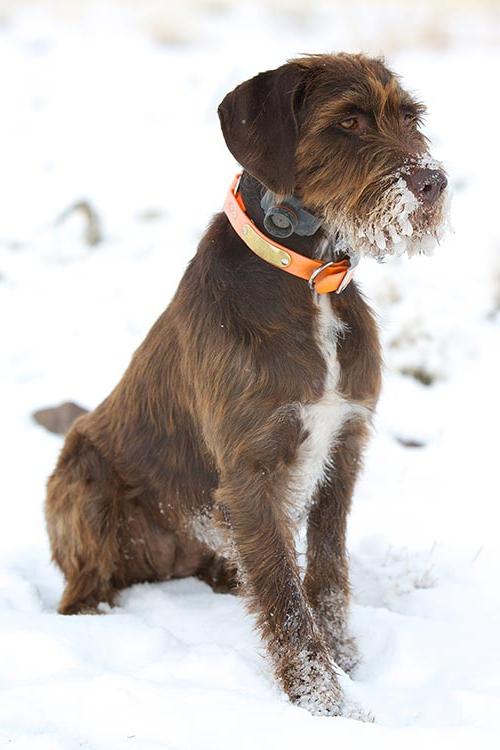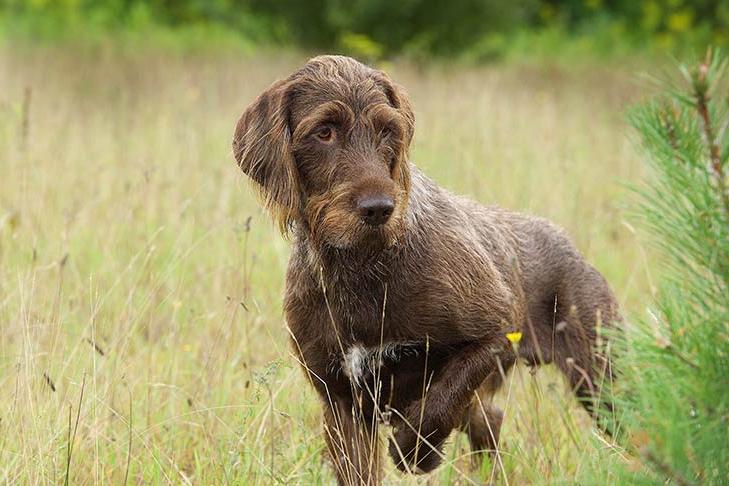- Breed Category: Gun dog
- Country of Origin: Germany
- Average Height: Males 60-68 cm, Females 55-63 cm
- Average Weight: Males 25-32 kg, Females 20-27 kg
- Average Life Span: 12-14 years
- Grooming Requirements: Low to moderate
- Exercise Requirements: High, needs daily exercise
- Coat Type: Dense, wiry
- Coat Color Variations: Liver, black, or chestnut
- Shedding Level: Low
- Ear Type: Floppy
- Tail Type: Straight, often docked
- Temperament: Intelligent, eager, friendly
- Intelligence Level: High
- Barking Tendency: Low
- Compatibility with Children: Good with proper socialisation
- Compatibility with Other Pets: Generally good
- Training Ease: Highly trainable
- Common Health Issues: Hip dysplasia, eye conditions
- Dietary Needs: High-quality, balanced diet
- Energy Level: Very high
- Drooling Tendency: Low
- Sensitivity to Weather: Moderate, tolerates cold well
- Overall Maintenance Level: Moderate
- Original Purpose: Hunting and retrieving
- Year of Recognition by Kennel Clubs: 2006 (AKC Foundation Stock)
- Apartment Friendly: Not ideal, needs space
- Best Suited For: Active families, hunters
- Cost of Ownership: Moderate to high
- Unique Traits: Excellent hunting instincts
The Pudelpointer is a versatile hunting dog, known for its intelligence and adaptability. Originating from Germany, this breed is a cross between the Poodle and the English Pointer, combining the best traits of both. Pudelpointers are celebrated for their keen sense of smell and strong swimming abilities, making them excellent companions for hunters and outdoor enthusiasts.
“The Pudelpointer is not just a hunting dog; it’s a loyal family member with a gentle disposition.”
– Renowned dog trainer, John Smith
This article aims to provide a comprehensive look at the Pudelpointer, exploring its unique characteristics, rich history, and essential care tips. Whether you’re considering adding one to your family or simply curious, read on to discover more about this remarkable breed.
History and Origin

Early Development of the Breed
The Pudelpointer’s story begins in the late 19th century in Germany. Breeders sought to create a dog that combined the intelligence and water-loving nature of the Poodle with the pointing and hunting prowess of the English Pointer. This blend aimed to produce a versatile hunting companion, capable of excelling in various terrains and conditions. The result was a breed that quickly gained a reputation for its adaptability and skill.
Role in Hunting and Retrieving
Pudelpointers are renowned for their exceptional hunting abilities. With a keen sense of smell and a natural instinct for retrieving, they are perfect for both land and water hunts. Their strong swimming skills make them particularly valuable for waterfowl hunting, while their endurance and agility allow them to cover large areas efficiently. This versatility has made them a favourite among hunters who need a reliable and capable partner.
Key Historical Figures
One of the pivotal figures in the creation of the Pudelpointer was Baron von Zedlitz, a passionate hunter and breeder. His vision and dedication were instrumental in developing the breed’s unique characteristics. By carefully selecting and breeding the best Poodles and Pointers, he laid the foundation for what would become a beloved and respected breed worldwide.
Physical Characteristics

Appearance
The Pudelpointer is a medium to large-sized dog, typically weighing between 20 to 30 kilograms. They stand about 53 to 66 centimetres tall at the shoulder. Their coat is dense and water-repellent, often coming in shades of brown, black, or liver. Some may have distinctive white markings on their chest or feet, adding a touch of uniqueness to their appearance.
Unique Physical Traits
One of the standout features of the Pudelpointer is its athletic build. These dogs are muscular and well-proportioned, designed for endurance and agility. Their webbed feet are a nod to their Poodle ancestry, making them excellent swimmers. This trait, combined with their strong, straight tail, helps them navigate through water with ease, a crucial skill for hunting and retrieving.
Temperament and Behaviour

Typical Personality Traits
Pudelpointers are known for their intelligence and eagerness to learn, making them highly trainable. They thrive on mental stimulation and enjoy tasks that challenge their problem-solving skills. With a moderate to high energy level, they require regular exercise to keep them happy and healthy. This breed is not just about brains and brawn; they also have a gentle and affectionate nature, making them a joy to be around.
Suitability as a Family Pet and Hunting Companion
As a family pet, the Pudelpointer is a fantastic choice. Their loyal and friendly disposition means they fit well into family life, providing companionship and protection. For those who enjoy hunting, their natural instincts and skills make them an invaluable partner. They seamlessly transition from a loving family member to a focused hunting companion, showcasing their versatility.
Interaction with Children and Other Animals
Pudelpointers generally get along well with children, displaying patience and playfulness. Their gentle nature makes them suitable for families with kids, though supervision is always recommended with younger children. When it comes to other animals, early socialisation is key. With proper introduction and training, they can coexist peacefully with other pets, although their hunting instincts may sometimes come into play.
Training and Exercise Needs
Importance of Early Training and Socialisation
Getting a Pudelpointer off to a good start with early training and socialisation is crucial. These dogs are smart and eager to please, but they need guidance to channel their energy and instincts positively. Introducing them to different environments, people, and other animals early on helps them grow into well-rounded adults. This foundation is key to preventing behavioural issues down the track.
Recommended Training Techniques
Positive reinforcement is the way to go with Pudelpointers. They respond well to praise, treats, and play as rewards for good behaviour. Consistency is important, so short, regular training sessions work best. Incorporating games and challenges keeps them engaged and makes learning fun. Remember, patience and persistence are your best friends when training this breed.
Daily Exercise Requirements and Activities They Enjoy
Pudelpointers are active dogs that need plenty of exercise to stay happy and healthy. A good mix of physical and mental activities is ideal. Daily walks, runs, or hikes are great, but they also love swimming and retrieving games. Interactive toys and puzzle feeders can keep their minds sharp. Keeping them busy helps prevent boredom and the unwanted behaviours that can come with it.
Health and Lifespan

Common Health Issues
Pudelpointers are generally healthy dogs, but like any breed, they can be prone to certain health issues. Hip dysplasia is one concern, a condition where the hip joint doesn’t fit together perfectly, which can lead to arthritis. Eye problems, such as cataracts, may also occur. Regular vet check-ups can help catch these issues early.
Average Lifespan and Tips for Keeping Them Healthy
The average lifespan of a Pudelpointer is around 12 to 14 years. To keep them healthy, a balanced diet and regular exercise are essential. These dogs thrive on activity, so keeping them engaged with walks, runs, and playtime is crucial. Mental stimulation is just as important, so consider puzzle toys or training sessions to keep their minds sharp.
Preventative Care Recommendations
- Regular vet visits for vaccinations and health screenings.
- Maintain a healthy weight through a balanced diet and exercise.
- Brush their teeth regularly to prevent dental issues.
- Check their ears for signs of infection, especially if they swim often.
- Keep their coat clean and groomed to avoid skin problems.
Grooming and Maintenance

Coat Care and Grooming Routines
The Pudelpointer’s coat is dense and water-repellent, requiring regular grooming to keep it in top condition. A weekly brush is usually enough to remove dirt and prevent matting. Use a slicker brush or a comb to work through any tangles, especially after outdoor adventures. Regular grooming not only keeps their coat looking great but also helps distribute natural oils, promoting a healthy shine.
Shedding and Seasonal Grooming Tips
Pudelpointers are moderate shedders, with shedding increasing during seasonal changes. During these times, more frequent brushing can help manage loose hair and keep your home cleaner. A good bath every few months or when they get particularly dirty will keep them smelling fresh. Always use a dog-friendly shampoo to avoid skin irritation. Regular grooming sessions are also a great opportunity to check for any skin issues or parasites.
Diet and Nutrition

Nutritional Needs for Optimal Health
Feeding your Pudelpointer the right diet is crucial for their health and vitality. These active dogs need a balanced diet rich in proteins, healthy fats, and essential vitamins. High-quality commercial dog food that lists meat as the first ingredient is a good choice. Look for options that cater to their size and energy levels.
Foods to Include and Avoid
Include lean meats, fish, and vegetables in their diet to provide necessary nutrients. Omega-3 fatty acids from fish oil can support their joint health and coat condition. Avoid foods high in fillers, artificial additives, and excessive grains, as these can lead to allergies or digestive issues. Chocolate, onions, and grapes are toxic to dogs and should be kept out of reach.
Feeding Schedules and Portion Recommendations
Establishing a consistent feeding schedule helps maintain their energy levels and prevents overeating. Adult Pudelpointers typically do well with two meals a day. Portion sizes depend on their age, weight, and activity level, so consult your vet for tailored advice. Always provide fresh water and monitor their weight to ensure they stay fit and healthy.
Fun Facts and Trivia

Interesting Tidbits About the Breed
The Pudelpointer is a unique blend of two distinct breeds, the Poodle and the English Pointer, each contributing its own set of skills and traits. This combination results in a dog that is not only a skilled hunter but also a loving companion. Did you know that Pudelpointers are known for their hypoallergenic coats? This makes them a great choice for families with allergies. Their webbed feet, inherited from the Poodle, make them exceptional swimmers, perfect for water-based activities.
Famous Pudelpointers in Media or History
While Pudelpointers may not be as famous as some other breeds, they have made their mark in the hunting community. Their reputation as reliable hunting dogs has been celebrated in various hunting magazines and documentaries. Although they haven’t starred in blockbuster movies, their loyal and hardworking nature has earned them a special place in the hearts of hunters and dog enthusiasts alike.
Final Thoughts
The Pudelpointer is a remarkable blend of intelligence and versatility. This breed excels as both a hunting companion and a loyal family pet. With its rich history and unique traits, the Pudelpointer offers a rewarding experience for those willing to meet its exercise and training needs. Embrace the journey of owning a Pudelpointer, and you’ll find a devoted partner in both adventure and everyday life. Consider welcoming this exceptional breed into your home and enjoy the many joys it brings.
